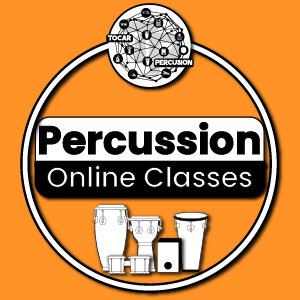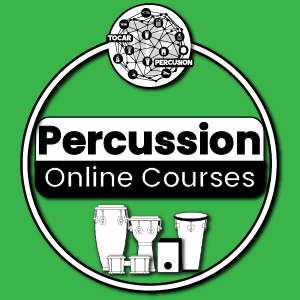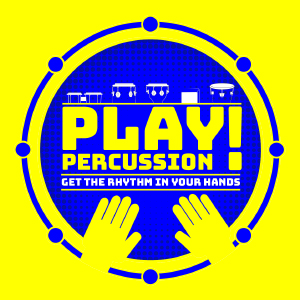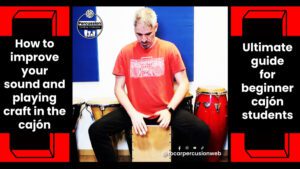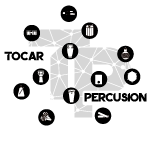Start your learning path in percussion today!
Learn to play the Cajon. Ultimate Beginner´s guide about hand technique and sounds
Author: Facundo Alvarez, Percussion teacher and Facilitator
Index of the post
How to sit properly to play the cajon
How to place your hands to play the cajon
How to play the different sounds in the cajon
Playing and Singing the notes of the Cajon
Hand motions in cajon playing
Hi folks!
This video is special for those of you that are starting to play the cajon and are struggling to get the right sound from the drum.
In this video, I’m going to revise several things that you have to take under consideration to play the Cajon correctly.
How to sit properly to play the Cajón
To sit down properly to play the cajon, your two feet have to be well placed on the floor. Try not to play balancing yourself.
Sit up straight, with your body relaxed. Don’t go into strange body positions to play the cajon, what I mean is don’t bend your spine back or forward to play, just keep it straight. Just try to feel comfortable with your body and feel relaxed.
Another thing, your legs have to open in a way that when you move around in and out of the cajon, you’re just hitting the cajon, and you don’t hit any other part of your body.
Last, to sit in the right spot of the cajon you´re going to do the following: You’re going to put your hand in the top of the cajon aligning the knuckles with the top of the cajon and you’re going to use this as a reference to leave that space when you are seated in it.
What I mean by that is don’t sit in front of the cajon. Instead, go a little back. In that way you´re going to be seated in the best position to play it.
How to place the hands to play the cajon
The second thing you have to take under consideration is the position of the hands when you play. So for that, what you’re going to do is make a triangle in front of your head and like you have it you put it down in the Cajon, maybe you can open a little in your hands, but keep them in that position, making a triangle between them.
How to play the different sounds in the Cajon
Let’s take a look now on how to play the different sounds in the cajon.
In the cajon you basically are going to play 3 sounds.So let’s see them in order iIn the order, going from the top of the cajon to the center
Playing Open sound in the Cajon
The first one is the open, that is the highest note you can play in the cajon. You’re going to play them in the border of the cajon using your fingers. For placing your hands correctly you´re going to use the middle articulation of your fingers. What I mean is you’re going to put your hands in the cajon and you’re going to look for that articulation to be aligned with the top of the Cajon. And in there you’re going to play. Remember to keep a triangle.
Playing Ghost notes in the Cajon
The second are the ghost notes, which aren´t really sounds. We can say that they are more like hits that are used for hand motion purposes. What I mean is they are hits that you´re going to use in the cajon to fill the void between the accents that you play using the rest of the sounds while you play rhythms on the drum.
To find the right spot for playing the ghost notes, you put the hand in the cajon using your knuckles as a guide. You have to align them to the top line of the cajon and keeping the triangle position you´re going to be in the right place to play them. To make them soft, you´re going to play them with the tip of your fingers. Play them very light so they sound really soft.
Playing Tone Sound in the Cajon
The last one is the tone, that’s the lowest note you can play in the cajon. To play it you´re going to move your hand to the center of the drum. So, to find the right spot you´re going to use your wrist and align them to the top line of the cajon. In this case, to play it you have to use your whole hand, both palm and fingers.
Try to avoid doing a common mistake, that is try to go too low in the cajon to play them. Again, align your wrist with the top line of the cajon and there is the right place for playing them.
Hand dynamic between sounds
So there you have, the different sounds that you can play depend on the part of the cajon you hit. In all of them the hand remains straight. Also, one important thing is that the ghost note has like two uses:
1 The first one is to fill in the void between the accents that you play using tones and opens
2 Second, they function as pivots to move between those two sounds.
Playing and Singing the notes of the cajon
One very useful resource that you can use to learn rhythms on the bongo and also remember them easily is learn and practice them using the “Melorhythm” method. With it you´re going to learn the rhythms by singing the different notes you play in the instrument.
The Melorhythm method can be applied to learning any percussion instruments, because in essence it works as a language for the percussionist and their drums.
In the case of the cajon, it works in this way:
- For singing the “Opens”, you´re going to use the syllable “TA”
- For singing the “Tone”, you´re going to use the syllable “TU”
- And for the ghost notes, you´re going to use the syllable “TI”
By combining them you´re going to be able to sing the melody of any rhythm that you learnt or you created in the cajón, making it easier for you to learn and remember them.
If you want to learn more about the “Melorhythm Method” click here.
Learn to play percussion online
¡Choose the way to learn to Play Percussion
that best suits your times and needs!
Learn to Play Percussion: Bongó, Conga, Cajón, Djembé, Timbal Brasilero
Percussion Online Classes
In the Online Percussion Classes, I offer individual and face to face classes for you to start learn to play percussion from scratch and learn to play and make music with the percussion instrument you like – Bongó, Cajón, Conga, Djembé or Timbal Brasilero.
Percussion Online Courses
In the Percussion Online Courses I offer you different virtual and self-paced courses options for you to start playing percussion from scratch and develop yourself as percussionist. Courses include several percussion instrument such as: Bongo, Cajón, Conga, Djembé or Timbal Brasilero.
Percussion Online Group Classes
In the Percussion Online Group Classes I offer grupal and face to face classes for you to start learn to play percussion from scratch and learn to play and make music with the percussion instrument you like – Bongó, Cajón, Conga, Djembé or Timbal Brasilero.
Activities suitable to all ages and levels
You don´t need to have previous knowledges of music or percussion to get started.
Hand motions to play the cajon
Let’s now focus on some specific stuff that you need to use to play the cajon properly. So, we’re going to revise several aspects that are related to the hand motion that you had to put in practice to improve your playing craft in the cajon.
Activate your wrist to play the cajon
The first one is that you have to activate your wrist to play. What I mean is that what you’re playing in the cajon has to come more from the movement of your wrist, than from the movement of your arms. In reality, the arm is going to move as much as the wrist asks for.
Why is that important?. Well, because if you use your wrist first, you’re going to be able to play faster. And second, you’re going to be in control of the strength that you use to play the drum.
When you play like this you´re in full control of your hands. You can go as high as you can to play louder and also you can play with a small movement to play softer. So your wrists are going to have the main key to control the volume that you use to play the cajon.
Take your hands away from the cajon
Another very common mistake most beginner cajon players make is play hanging from the cajon. What I mean is too close. Sometimes they also play and they leave their hand leaning on the cajon.
To improve your playing craft in the cajon you need to avoid doing that. Instead you need to find some room between your hands and the cajon. Because in that way you are going to reduce your margin error. What I mean is when you are too close to the cajon sometimes you don’t have enough time and space to build the sounds correctly. So, by avoiding doing that you´re going to improve your playing craft in the cajon.
Taking your hands away from the cajon and using your wrist to play is going to improve your playing craft in the cajon. This is going to help you to achieve a better sound from the cajon and also you´re going to be able to play faster in it.
Practice hand technique in the cajon in “Horizontal Position”
This I´m going to share with you is something that I took from my conga playing craft and take to the cajon.
The common approach in the cajon is to practice everything that you play with your hands in a vertical position. That is the normal way, because you play the cajon also in that position.
So why do I suggest you practice in a different position?. Well there are several benefits for your playing skills.
- The first one is that you´re going to have a different perspective of your hands while you play the cajon, that is going to allow you to see things that you can´t see when you play the exercises in the “vertical position”.
- Second, gravity is going to be in your favor. What I mean is the force of gravity is going to make you use your wrist more to play, than in the “vertical position”. So practicing in this “horizontal position” is going to help you, first, to activate the wrist and second to taking your hands away of the Cajon
To practice in the “Horizontal Position” you have to look for some surface that is similar to the cajon. It can be a table, it can be a chair or maybe some sort of bank, Look for some element like that and play and practice rhythm and exercise in the cajon in that way.
So this is the end of the video. I hope you find it useful and entertaining and that you can use any of these advice on your own on your learning path in the cajon.
I´ll see you in the next video.
Read more post
percussion facilitator
Facundo Alvarez
Percussion Facilitator
For 20 years I´ve dedicated myself to develope educational and recreational materials and experiences, with the goal of facilitate access to percussion learning to people of all ages
In all the projects I work motivated by the premise that "Percussion is for everybody" and that "Everyone can learn to play percussion".
My main goal is to help, as many people as I can, to live the unique experience of making music with percussion instruments.
